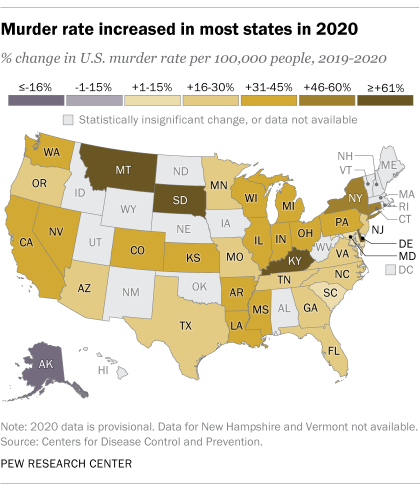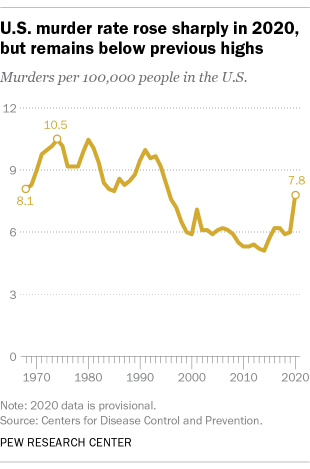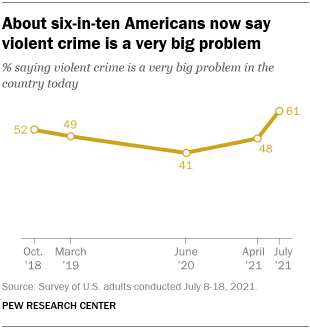The U.S. murder rate rose 30% between 2019 and 2020 – the largest single-year increase in more than a century, according to data published this month by the Centers for Disease Control and Prevention (CDC). The findings align with a separate tabulation of the nation’s murder rate published in September by the FBI.
The CDC tracks murders by analyzing information contained in death certificates. The FBI tallies murders by collecting information from thousands of law enforcement agencies across the country. Despite their different methodologies, both sources point to a sharp rise in the U.S. murder rate during the pandemic year of 2020, even as the rate itself remained well below the level of earlier decades.
Below are some key takeaways from the two new sets of government data.
This analysis examines the increase in the U.S. murder rate between 2019 and 2020. It relies on murder statistics from the Centers for Disease Control and Prevention (CDC) and the FBI. In this analysis, the terms “murder” and “homicide” are used interchangeably.
The CDC’s murder data is based on information contained in death certificates and published in two online databases. Data for 2020 comes from the Vital Statistics Rapid Release mortality dashboard, while data for earlier years comes from the WONDER database. Data for 2020 is provisional; data for earlier years is final. All murder rates are adjusted for age. Provisional data for 2020 was not available for New Hampshire and Vermont at the time of this analysis. Historical data on nationwide murder rates is not directly comparable across the 1968-2019 time period due to minor definitional changes made by the CDC in accordance with the World Health Organization’s International Classification of Disease.
The FBI’s murder data is based on information submitted to the agency by local police departments around the country and published on the Crime Data Explorer website. The FBI data is incomplete because not all agencies participate in the voluntary program every year and some of those that do participate do not provide full data. The FBI’s figures include nonnegligent manslaughters as well as murders.
The public opinion data cited here comes from Pew Research Center surveys conducted in 2021 and 2020. Additional information about the sample sizes, field dates and methodologies of these surveys can be found in the links included in this analysis.
The year-over-year increase in the U.S. murder rate in 2020 was the largest since at least 1905 – and possibly ever, according to provisional data from the CDC. (Final data is not expected to differ much from the provisional data.) There were 7.8 homicides for every 100,000 people in the United States in 2020, up from six homicides per 100,000 people the year before. The rise in the nation’s murder rate last year far exceeded the 20% increase measured in 2001, which was driven by the terrorist attacks of Sept. 11.
Last year’s increase in the murder rate may have even exceeded the one measured in 1905, according to Dr. Robert Anderson, who oversees mortality statistics for the CDC’s National Center for Health Statistics. Anderson noted earlier this month that the 1905 increase was at least partly due to more states submitting data to the national death registry, as opposed to an actual rise in murders.
The CDC has not yet published the total number of murders in the U.S. in 2020. But according to the FBI, there were 21,570 murders last year, up 29% from 16,669 in 2019 and the highest annual total since 1995. The FBI figures include nonnegligent homicides as well as murders, but the agency’s figures are incomplete because not all law enforcement agencies submit data.
Most states saw their murder rates go up between 2019 and 2020. At least eight states saw their murder rates rise by 40% or more last year, with the largest percentage increases in Montana (+84%), South Dakota (+81%), Delaware (+62%) and Kentucky (+61%), according to the CDC. Higher-than-average increases also occurred in several heavily populated states, including New York (+47%), Pennsylvania (+39%), Illinois (+38%), Ohio (+38%) and California (+36%). The CDC does not yet have full-year data for New Hampshire and Vermont.
Firearms were involved in 77% of murders for which data was available in 2020, up from 73% in 2019, according to the FBI. As has long been the case, handguns were involved in a majority of gun murders, while rifles and shotguns accounted for much smaller proportions. A sizable share of gun murders in 2020 involved an unknown type of firearm.
The percentage of murders that were solved – known as the “clearance rate” – declined from 61% in 2019 to 54% in 2020, according to the FBI. The murder clearance rate refers to the share of homicides that are closed through the arrest, charging and referral of a suspect for prosecution, or due to “exceptional” circumstances such as the death of a suspect or a victim’s refusal to cooperate with a prosecution. Clearance rates are calculated based on the number of offenses closed in a given calendar year, even if the crime may have occurred in a prior year.
It is not yet clear why murders rose dramatically in 2020. Experts have pointed to a variety of potential causes, including the economic and societal changes brought on by the coronavirus pandemic and changes in police-community relations after the murder of George Floyd in Minnesota last year. But the exact reasons remain unclear.
The FBI data, at least, shows that murder wasn’t the only form of violent crime to go up last year. The rate of aggravated assault rose nearly 12% between 2019 and 2020. And since aggravated assault is by far the most common type of violent crime tracked by the FBI, the overall violent crime rate in the U.S. also increased in 2020, by about 5%. Two other kinds of violent crime tracked by the FBI – rape and robbery – declined in 2020.
Despite rising sharply in 2020, the U.S. murder rate remains below the levels of the early 1990s. The 2020 homicide rate of 7.8 homicides per 100,000 people was 22% below the rate of 1991 (10 homicides per 100,000 people) and far below the rates recorded in much of the 1970s and 1980s, according to the CDC. As is the case for violent and property crime rates more broadly, the U.S. murder rate has generally trended downward in recent decades, though 2020 was an obvious exception.
Americans remain far less likely to die from murder than from other causes, including from suicide and drug overdose. The U.S. murder rate in 2020 was 42% lower than the suicide rate (13.5 deaths per 100,000 people) and 71% below the mortality rate for drug overdose (27.1 deaths per 100,000 people, as of the third quarter of 2020), the CDC data shows. As was the case with murders, drug overdoses increased sharply in 2020.
That’s not to say that Americans aren’t concerned about violent crime. In a July 2021 Pew Research Center survey, 61% of U.S. adults said violent crime is a very big problem in the country today – up from 41% in June 2020 and the highest percentage measured since at least the fall of 2018. In the July poll, Americans were more likely to describe violent crime as a very big problem than to say the same thing about five other issues asked about in the survey: the federal budget deficit (50% said this was a very big problem), climate change (47%), racism (45%), economic inequality (44%) and illegal immigration (43%).
Since June 2020, Americans have also become more supportive of increasing local police funding in their communities. In a separate Center survey conducted in September, 47% of U.S. adults said they favored an increase in funding for police in their area, up from 31% last June. Support for reducing local police funding declined from 25% to 15%.







